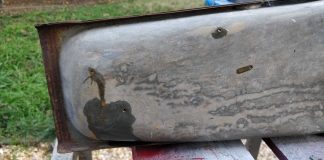If you’re a Do-It-Yourselfer, you’ve probably done it wrong a few times. Everyone has. This is how you learn – hopefully, not to do the same thing again.
Here are a few classics from the Mashed Finger File; if you haven’t already done ’em – try not to do ’em!
* Jack up the car on grass or dirt … and get underneath it –
More people are surely maimed and even killed each year as a result of dumbo Don’t Do car jacking techniques than are mauled by sharks or killed by lightning. Even hard-packed dirt can give way once the weight of a two-ton car is hoisted on it. Gravel shifts – and grass is soft.
Always raise the car on a level, hard surface such as a concrete driveway pad (or similar). And: don’t ever crawl underneath the car before the frame is properly supported by fixed jack stands.
Not just the jack. Because jacks can leak.
* Use regular rubber fuel hose in a fuel injected car –
Unless you like engine fires, of course. The pressure in the fuel lines of a modern fuel injected car can be as high 40 psi or more vs. 3-6 psi or so in a car (mostly early 1980s and older) equipped with a carburetor. Fuel injected cars use hose that is rated to withstand much higher operating pressures; regular fuel hose isn’t. While there may be (and ought to be) markings on the hose indicating its rating (“for fuel injection,” etc.) it’s still important to be 100 percent sure you’re using the right stuff. Same with the connectors/clamps. Because fuel injection systems usually have specific clamps that are designed for the higher operating pressures of EFI.
* Splicing damaged brake lines –
This Don’t Do is even more potentially dangerous than the use of regular (low pressure) rubber fuel hose in a high-pressure, fuel-injected car. Because at least with an engine fire, you’ll probably be able to stop the car, get out – and flee the scene. But if the brakes fail due to hydraulic problems caused by a cheesy spliced-in section of line … you can’t just open the door and get out at 60 mph.
If a steel brake line is damaged or rusty, the proper repair is to replace the entire section with a new steel line. Never patch a section like you might a leaky kitchen sink. Unless you’re looking to try an unusual form of assisted suicide.
* Drive around on less than all your lug nuts –
Most passenger cars have either four or five lug nuts securing each wheel to its hub. None of the individual lug nuts (or studs) are optional. It’s a serious Don’t Do to drive around with one (or more) lug nuts not secured because you (or the Quick Lube place) sheared off the stud or something like that. The wheel can come off while you’re toodling down the road – and when it does, the car will likely suffer violent loss of control as the weight shifts suddenly and unexpectedly. At the very least – if you’re lucky – all you’ll be is seriously stuck and looking at a fat tow bill. More likely, you’ll have wrecked the car or caused it serious damage. All because you were too cheap (or lazy) to fix a $5 wheel stud – or replace a 75 cent lug nut.
* Ignore the “check engine” light –
Since about the mid-’90s new cars have come with On Board Diagnostics (OBD). This means the computer that controls the engine continuously self checks its various systems and, when something’s not right, lets you know by triggering the amber “check engine” light on the dash.
Typically, the fault is emissions related, which means it’s still safe to drive the car. But even though the car may seem to be running ok, it doesn’t mean you should ignore the warning light indefinitely.
For one, your gas mileage will probably go down because the engine’s not operating at peak efficiency; it may be in what they call “open loop” – and so, burning more fuel. For two, your car’s tailpipe emissions may be higher than they ought to be – which may not bother you directly, but will definitely cause you problems when your car fails smog check.
But most important of all, the “check engine” light might be warning of a problem that could lead to expensive repairs (such as replacing a ruined catalytic converter as a result of bad O2 sensors) if you don’t get whatever’s not right checked out – and fixed, if need be.
* Drive at high speed/for extended periods on a Space Saver tire –
Many new cars no longer come with full-size spare tires. Instead, they have a space saver’ temporary tire that is often much smaller than the normal tire they are stepping in for. These temporary spares are are designed only to let you gimp to the next available tire store or get you home. That’s it. They are not intended for high-speed driving – and almost always will negatively affect the way your car handles and brakes.
If you don’t want to wreck, don’t drive on the space saver for more than about 50 miles or faster than about
50 mph. (Your owner’s manual will have specific warnings and cautions applicable to your particular vehicle.)
* Overload your pick-up –
Who hasn’t been tempted? You don’t want to have to make two trips to the store; so instead of doing the right thing you do the wrong thing and have the forklift guy put a full load of bricks in the bed that makes it sag so low you can almost hear the shock absorbers screaming. You may soon hear them doing something else…
Evil handling/braking (in addition to potentially damaging excessive load on those shocks as well as other suspension components) will result from loading your vehicle beyond what it’s rated to carry – and could result in permanent, expensive damage to the vehicle as well as an accident.
If you do cause an accident while driving an overloaded vehicle, keep in mind that you could be criminally charged as well as end up being sued out of your house and into a van down by the river by the person you hit.
Keep it in mind. That extra trip is almost always worth the hassle.
Throw it in the Woods?










It was the spring of ’85 and I now recall the use of ramps. He’d built an A frame to lift the motors up and we had put up a cheap tarp to cover our stuff up. I was in Jr. high at the time and the kids thought I was trying to go punk for all the red splotches of transmission fluid in my hair. 🙂 My Dad was meaner than any Drill Instructor. I hated coming home from school during that time. I’d get screamed at from the minute I came home to school to midnight or whenever he’d decide to knock off. Needless to say, I never held much interests in auto mechanics other than to do the basics. Just didn’t have the fascination for parts and shop talks like other dudes after that. Now, I wish I had gotten into mechanics with the failing economy and all.
I helped my Father rebuild the engines of two Ford Mavericks one Dodge Swinger and one Chevy Malibu out in a grass lot next to the house. We took out transmissions , replaced universal joints, brake jobs, etc. Never had a problem with the jacks sinking too low, we did use jack stands and wood though.
Ha HA!
I once made the mistake of ignoring a ‘check engine’ light.
The cat cost me $400.
Yup!
Some cars have four cats; so you can see how it can get very expensive, very fast.
I understand not haphazardly patching brake line, but others find proper brake line flares, fittings, and unions to be some horrible thing. Sure it’s one more connection but if the flares are made correctly it’s not going to leak and the typical failure of the fittings is braking the line when they rust up and cannot be separated, not spontaneous leaks. I also understand that there may be rust elsewhere in a line, but I’ve also seen very localized rust in very long brake lines. This to me seems to be one of those rules that is made just to discourage people from doing dumb things rather than any inherent problem with an extra fitting.
I’ve been an emergency physician for 30 years. I’ve seen two men killed while working under cars held up by jacks only. For Heaven’s sake, you can get a set of jack stands and wheel chocks at Harbor Freight for about $30!!!!
Also, carry an approximately 12″ x 12″ piece of 3/4″ plywood in your car. If you have to change a flat on a muddy or sandy road – your jack won’t sink into the ground.
NEVER NEVER NEVER work under a car held up by a jack only!! That way I won’t have to explain to your wife how you died.
Hi John,
Amen.
It’s amazing to me how cavalierly careless some people can be – just to save a little money (as they see it) or a little time (too lazy to get/buy what they need).
PS: I’ve personally seen a car fall off a lift (not secured properly) and that was plenty sufficient to make me appreciate a few basic facts about physics and gravity!
No doubt. When I mess around on the ground (which happens often) I do one of two things. First one is straddle a ditch and work under the car with it in park, parking brake, and wheel chocked. Second, if the unit is up in the air I have 3 separate supports for each one. Example: If I am up on ramps I have the ramp, then 4x4s stacked, and roll a correct size tree stump under the frame rail. A bit over an over kill, no pun indeed, I know.